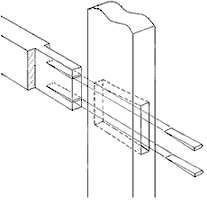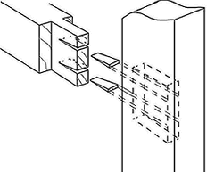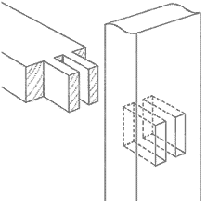Mortise and Tenon joints for timber
basic mortise and tenon - stub joint - haunched joint - double tenon - twin tenon
A mortise and tenon joint consists, in simple terms, of a 'tongue', (the tenon) that slots into a hole (the mortise) cut in the mating piece of timber.
The strength of the joint makes it ideal for use in framing and general furniture work. For a really strong joint the tenon must be a tight fit into the mortise, so care must be taken when cutting both parts of the joint.
For maximum strength, the tenon width should never be more than one third the width of the timber in which it is cut.
There are several kinds of mortise and tenon joints. They all serve much the same purpose; but some are stronger, while others conceal the joint construction.
Through mortise and tenon the basic joint.
 The basic mortise and tenon comprises of a tongue(tenon) cut into one rail and a mortise cut all the way through the other rail. The joint can be strengthened by fitting dowels (see below for stub tenons) or by fitting wedges.
The basic mortise and tenon comprises of a tongue(tenon) cut into one rail and a mortise cut all the way through the other rail. The joint can be strengthened by fitting dowels (see below for stub tenons) or by fitting wedges.
 If wedges are used, two saw cuts (about two thirds the length of the tenon) should be made in the tenon and the ends of the mortise should be cut back so that the outer end of the mortise is longer than the inner face, then the end of the tenon will be expanded by the wedges to lock the two pieces together. Only insert the wedges after the joint has been fully assembled.
If wedges are used, two saw cuts (about two thirds the length of the tenon) should be made in the tenon and the ends of the mortise should be cut back so that the outer end of the mortise is longer than the inner face, then the end of the tenon will be expanded by the wedges to lock the two pieces together. Only insert the wedges after the joint has been fully assembled.
Stub (or blind) tenon
 A neater version is the stub tenon, since the mortise does not go all the way through the timber, so the end of the tenon is concealed. The joint can be strengthened by securing with dowels or wedges.
A neater version is the stub tenon, since the mortise does not go all the way through the timber, so the end of the tenon is concealed. The joint can be strengthened by securing with dowels or wedges.
If dowels are used, fully assemble the joint and ensure that the shoulders of the tenon are tight against the mortise rail before drilling the holes, make the holes tight for the diameter of the dowels. Use a wooden mallet or a block of wood under a hammer to protect the end of the dowels when they are driven home.
The dowel holes do not need to go right through the rail (this will give better appearance on the 'far face') but should enter the far side of the mortise.
 To secure with wedges, the ends of the mortise should be cut so that the bottom of the hole is longer than the top, then the end of the tenon will be expanded by the wedges to lock the two pieces together. Two saw cuts (about two thirds the length of the tenon) should be made in the tenon. Precision is necessary when using wedges, only one attempt at final assembly is normally possible once the wedges are fitted.
To secure with wedges, the ends of the mortise should be cut so that the bottom of the hole is longer than the top, then the end of the tenon will be expanded by the wedges to lock the two pieces together. Two saw cuts (about two thirds the length of the tenon) should be made in the tenon. Precision is necessary when using wedges, only one attempt at final assembly is normally possible once the wedges are fitted.
The risks are that the wedges will be driven fully home before completely expanding the tenon or the tenon will be fully expanded before the shoulder of the tenon meets the mortise rail.
Haunched tenon
 This is similar to the basic through tenon, but has a shoulder (haunch) cut on the top of the tenon - and a matching recess cut in the upper end of the mortise. The haunch piece should protrude no more than one quarter along the tenon and should be cut down the same measurement to form a square haunch.
This is similar to the basic through tenon, but has a shoulder (haunch) cut on the top of the tenon - and a matching recess cut in the upper end of the mortise. The haunch piece should protrude no more than one quarter along the tenon and should be cut down the same measurement to form a square haunch.
Double or multiple tenon
 For use on wide pieces of timbers, the additional surface area of the tenons will give a stronger joint than a single tenon.
For use on wide pieces of timbers, the additional surface area of the tenons will give a stronger joint than a single tenon.
Any number of tenons may be cut so long as their widths and the gaps between are the same.
The joint can be further strengthened by using a dowel as previously described.
Twin tenon
 Traditionally used for the centre rail of doors and other applications where the tenon rail is relatively wide in relation to its thickness. The tenons are linked by a haunch for greater strength and the mortise is 'stepped' to correspond.
Traditionally used for the centre rail of doors and other applications where the tenon rail is relatively wide in relation to its thickness. The tenons are linked by a haunch for greater strength and the mortise is 'stepped' to correspond.
basic mortise and tenon - stub joint - haunched joint - double tenon - twin tenon
